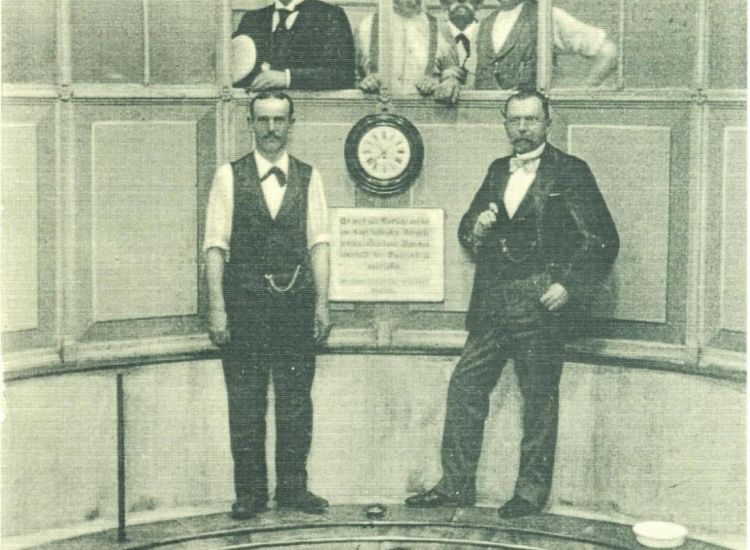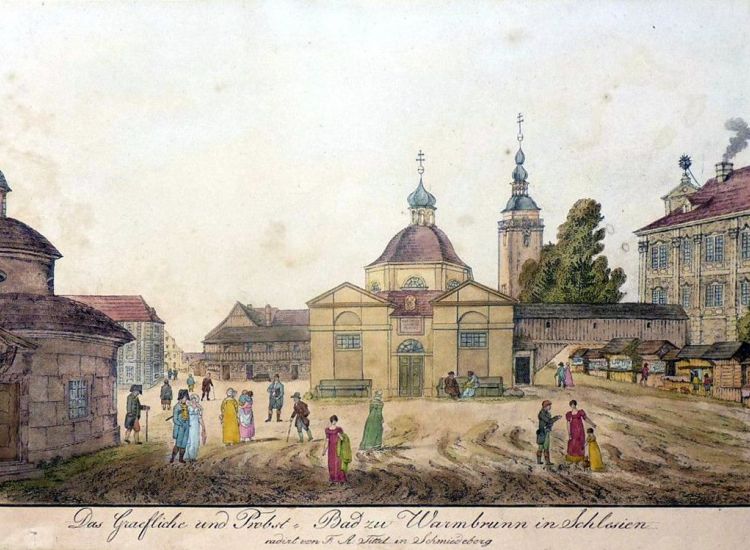HISTORY OF THE CIEPLICE HEALTH RESORT
The Cieplice Health Resort ("Uzdrowisko Cieplice" Sp. z o.o.) continues the centuries-old tradition of using natural raw materials for therapy. Balneological treatment has been conducted continuously since 1281, thus the Cieplice Health Resort is the oldest resort of this kind in Poland.
In the middle of a large, flat table-like lowering, at the foot of the majestic Karkonosze, bathed in greenery, over which only the church towers and the red roof of the palace are seen, there are facilities of Cieplice. Circumstances of the Cieplice uprising are hidden in the darkness of the past. Legend tells, however, that they originated from a hunting manor house erected near the springs, the water of which healed a deer wounded by the prince of Silesia Bolesław Wysoki during hunting. For a quarter of a century, Cieplice has been part of Jelenia Góra. Previously, they were a separate town, whose historically confirmed beginnings are dated back to the second half of the thirteenth century. The local warm springs were already known at that time. Because of them also the village took its name both in German - Bad Warmbrunn (Villa Warmbrona 1288), Latin - Callidus fons (1281) and in Polish - Cheplewode (1318).
The close connection between the place and the hot springs is confirmed by even the oldest surviving document that concerns them. In 1281, the Duke of Lviv, Bernard, donated the local springs and the surrounding area to the Order of Joannites from Strzegom. The Joannites is a order taking for the sick, running hospitals. In the nearby village of Malinnik (today part of Cieplice stretching along Kamienna and Wrzosówka) they erected in 1288 a hospital for the sick. The circumstances of the departure of the Joannites from Cieplice are unknown. Their new owner in the second half of the 14th century, when whole Silesia was already part of the Czech Crown, was Gotsche Schoff, a knight on the services of Prince Bolek II Świdnicko-Jaworski. The town remained for centuries in the hands of his descendants, the Schaffgotschs. The protoplast of this great family in 1403 gave one of the two sources known at that time to the Cistercians brought here from Krzeszów. From now on, both the Schaffgots and the monks conducted here therapeutic activities.
Already in the 16th century, many visitors from all over the Reich and even Poland were coming to Cieplice Zdrój. Together with the Czech Kingdom in 1526, Cieplice became part of the Habsburg monarchy. In 1569, the physicist Caspar Hoffmann examined and described the local thermal waters. After him, in 1607, Caspar Schwenkfeldt, an eminent naturalist, a town doctor from Jelenia Góra, did it again.
The Thirty Years War certainly stopped the further development of the health center, although not much information from that time was preserved. The second half of the 17th century is a period of frequent treatment of outstanding personalities from Poland, which is probably associated with the "ambassadorship" of Christoph Leopold Schaffgotsch at the Polish court. His guests were among others Grand Lithuanian Chancellor Albrycht Stanisław Radziwiłł (1653), Castellan of Wieluń Zygmunt Radziwiłł (1677) and Primate Michał Radziejowski (1692). The most prominent guest in Cieplice was the Polish queen Marysieńka Sobieska, who was enjoying her numerous court in 1687. Her visit was long remembered by the inhabitants of Cieplice.
In the 17th and 18th centuries the resort was also famous for glass grinding. From 1741, Cieplice became part of the Prussian state. The turn of the eighteenth and nineteenth centuries brought the visits of many distinguished guests. Among them were Johann Wolfgang Goethe (1790), Prussian King Frederick William III with his wife (1800), John Quincy Adams later president of the USA (1800), Hugo Kołłątaj (1792 and 1808), Józef Wybicki (1802) and Izabella Czartoryska (1816). After the secularization of the Cistercian estate, the Schaffgotsch family acquired a monastic health resort in 1812. In this way, the entire health resort was in their hands. From the second half of the 19th century, the Schaffgotsch collections became a great attraction of Cieplice. These included, among others, the library, armory as well as ethnographic and mineralogical collections.
The most famous, however, was the ornithological office, which is considered the largest private collection in Europe. At that time, several outstanding ornithologists were associated with Cieplice: Ernst Luks and his pupils - Otto Finsch (later a traveler and colonizer of Papua New Guinea) and Georg Martini (creator of the Schaffgotsch ornitological collections). Also in the mid-19th century, outstanding persons came to the Cieplice waters: the writers Karl von Holtei and E.T.A. Hoffmann or painter Caspar David Friedrich, among Poles - Wincenty Pol and Kornel Ujejski (1847). From the middle of the 19th century, first the repair workshop in Cieplice and then the paper machine factory of Eugen Füllner expanded. In 1902, an excellent carving school was established here.
The entire Cieplice region was also famous for its annual fair called "Tallsackmarkt", during which excellent gingerbread was sold. Shortly before World War II, the Podkarkkonoski health resort received city rights, which it enjoyed until 1975, when it was joined to Jelenia Góra. The war itself did not cause damage to the city. After the war, the Schaffgotsch collection was dispersed and the health resort gradually lost its old reputation. Fortunately, Cieplice has been slowly recovering its rightful position in recent years. Thanks to numerous investments of the city and the "Uzdrowisko Cieplice" company, the patients have at their disposal a modern treatment base and the Cieplice Old Town has regained its former splendor. It seems that as before, the Cieplice prosperity is related to their sources.









